Samsung Galaxy Fold Review
Samsung Galaxy Fold Review
More of a foldable tablet than a foldable phone, the Galaxy Fold excels in some areas and disappoints in others
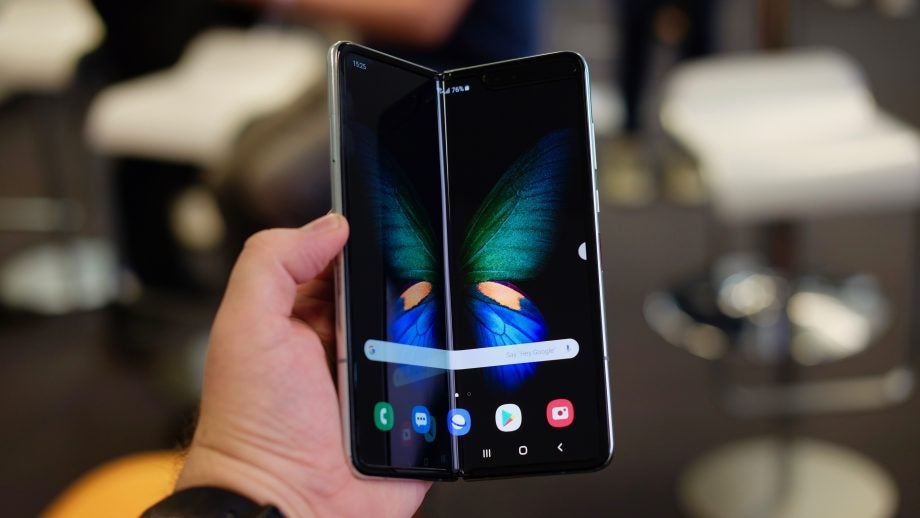
Verdict
As much as the Galaxy Fold is a look at what the next wave of smartphones might be, at this stage it’s hard to recommend that anyone, aside from those who simply must have the first-gen of everything, actually spend nearly £2000 on it. It’s impressive in a number of areas: great battery life, nice and productive software that actually makes some use of the bigger display and there are certain situations where having a tablet in smaller form-factor work.
Pros
- Genuinely innovative form-factor
- Great battery life
- Galaxy Buds in the box
- Loads of cameras
Cons
- It’s too delicate
- Outer display feels too limited
- It’s better as a tablet than a phone
- Cameras aren’t class-leading
Key Specifications
- Review Price: £1900
- 7.3-inch foldable display
- 4.6-inch FHD+ outer display
- Snapdragon 855
- 12GB RAM
- 4380mAh battery
- 512GB storage
- 12MP + 12MP + 16MP cameras on the back
- 10MP + 8MP front cameras
The Samsung Galaxy Fold has had a tough year. Issues with the foldable screen marred the launch and it wasn’t until six months after its glitzy unveiling, alongside the Galaxy S10, that you could actually walk into a store, lay down nearly £2000 and own the first commercially available foldable phone.
Ever since I first held the Fold many months ago I have been eager to properly use it. To see if that tiny outer display was a waste; to see if the obvious crease down the middle would be off-putting and just generally to understand whether the hype around these devices is worthy.
After a week of feeling very self-conscious about unfolding a £2000 piece of kit on a rammed London Underground Tube and feeling both impressed and disappointed in equal measure, I can see why foldables will, eventually, be the future.
The Samsung Galaxy Fold, however, is clearly a first-gen product that just makes me more excited about what is going to come next.
It might also be worth holding off on buying the Fold as we expect the Samsung Galaxy S20 launch to bring with it a new foldable.
- Check out our hands-on Galaxy Note 20 review and Galaxy Note 20 Ultra review
Screen and Design – An impressive achievement, even with the issues
The Galaxy Fold suffered numerous issues when it first launched. Early US-based reviewers struggled with debris getting caught under the panel and some even peeled off the outer layer of the foldable panel mistakenly thinking it was a screen protector. Not a great start.
Fast-forward six months and the Fold I am using is actually different to that original device. Not enough for Samsung to call it the Galaxy Fold 2, but enough to make it feel slightly different to use. The screen now runs right under the bezel (you couldn’t even attempt to peel it off) and there are thicker caps at the top and bottom to try and avoid stuff getting caught under the panel.
These fixes, for me anyway, seem to have worked and during my time with Fold it hasn’t broken. Which is, of course, good news.
Look past those initial issues and it’s hard not to get a feeling of excitement when you unbox the Fold. The phone consists of two screens: an outer 4.6-inch (1680 x 720) and an inner display that folds out into a 7.3-inch (2152 x 1536) almost square screen. That outer screen immediately looks odd, as there’s a (very) hefty bezel around it. Why this display doesn’t run edge-to-edge seems like an obvious design flaw and one that’ll hopefully be addressed in the followup.
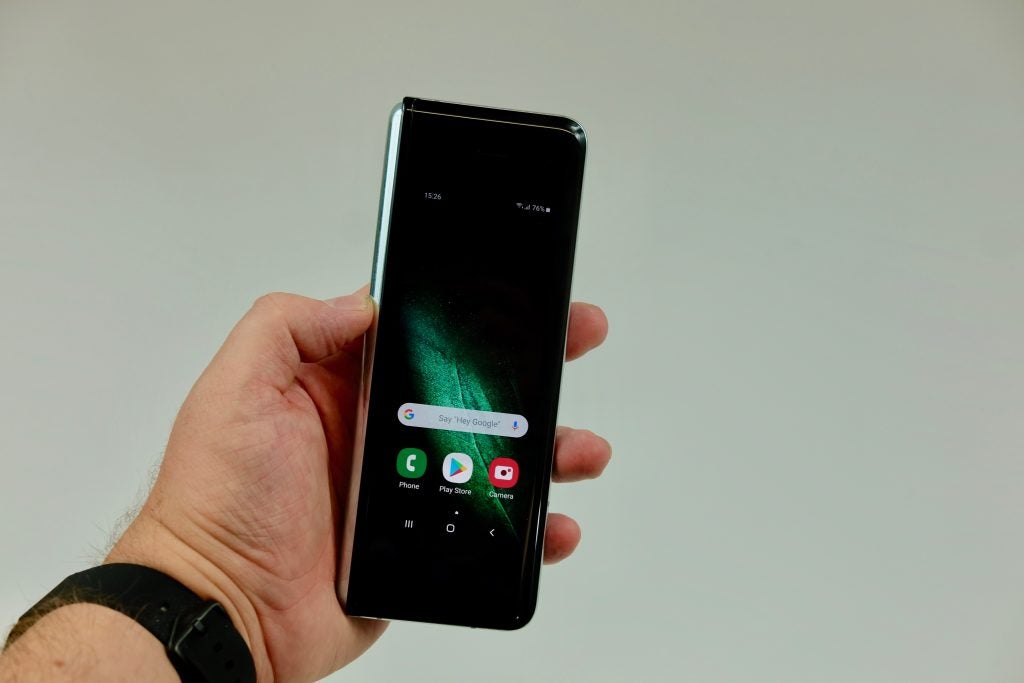
The outer display is mainly used for notifications
Due to its small size, I mainly found myself using this 4.6-inch screen to answer calls, check incoming notifications and the time. Beyond that, it’s simply too small. Trying to type an email on the dinky keyboard is an unhappy task and while you’ve got full access to Android and all your apps, you won’t really want to game or watch Netflix on it. To be honest, I think Samsung knows this, but there really needs to be more to this outer display than just being a glorified notification panel.
It’s when you unfurl the Fold that the fun really starts. This turns an oddly-shaped phone (someone in the office said it resembled a landline phone) into an almost mini-tablet that you can slip in your pocket. Thanks to some clever software continuity, if you have a WhatsApp message open on the outer display and unfold the Fold it’ll show up instantly on the bigger screen. For the apps that support it, this is great, and even for the ones don’t it only requires the app to restart, and that just takes a couple of extra seconds.
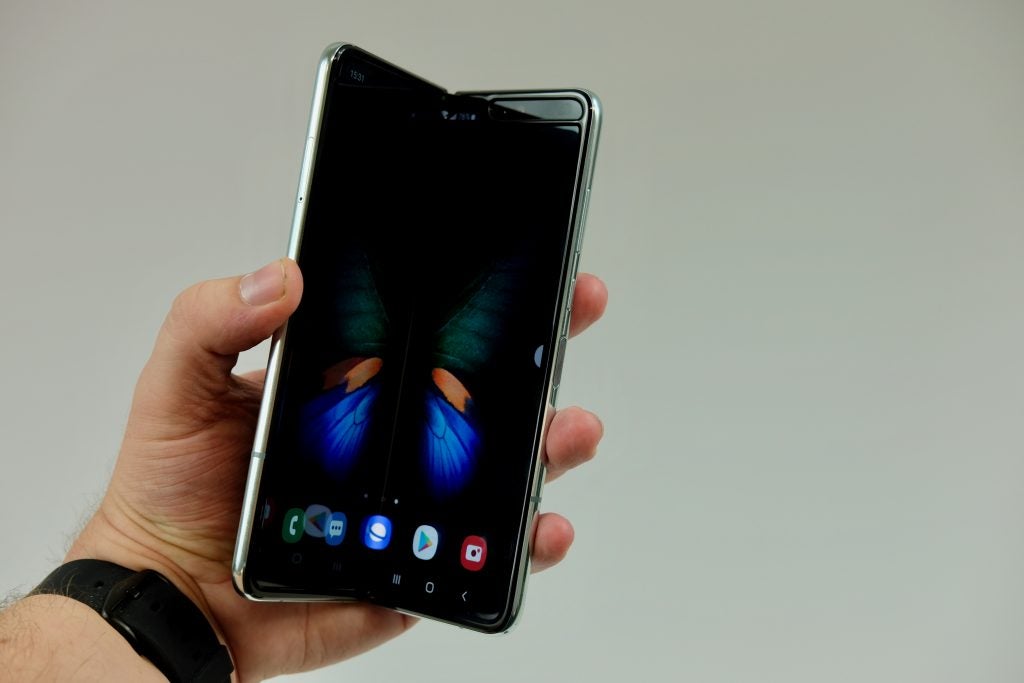
The squared-off nature of the inner screen doesn’t immediately suit video – you’ll have hefty black bars on the top and bottom – but I still absolutely love watching YouTube, Netflix and Prime Video on this thing. Flip it open on the train and you’ve got a tiny tablet that doesn’t require you to delve into your bag to reach. Quality-wise the screen is good: It’s OLED (both panels here use Samsung’s Super AMOLED tech) so you’ve got inky blacks and vivid colours, supports HDR10+ and gets very bright.
The screen isn’t perfect though, and I think the limitations are more obvious because of how good it could be. The biggest irritant is that the screen is covered in plastic, rather the usual glass. This is obviously required for the whole folding thing to work, but it makes for a panel that’s overly reflective, has an almost dimpled look and gets greasy and fingerprint covered very quickly. I feel like I am wiping this display down every time I want to use it. Plastic is also less durable than glass, so even a strong press with the tip of your thumb could cause damage. You’ll need to really treat this display with care.
Another issue is the crease. Which, again, feels like something that’s going to be a problem with foldables for the next few years. You can clearly see the line down the middle of the screen where it folds and it’s a distraction – especially when you’re looking at it from an angle or in bright sun. It’s there, it’s annoying and it’s hard to get over. There’s also a notch on the right-hand side which houses two front cameras – again, getting in the way.
Even with all these issues, the idea of the Fold is fantastic. Having a large view of Google Maps in your hand is fantastic and it works well as an (admittedly wildly expensive) e-book reader. I was sold on the future of foldable after a few days of using the Fold.
Away from the screen the Fold remains a mixture of great and annoying. There’s absolutely no water-resistance rating, for example, and I felt like it was constantly babying the phone whenever there was a slight drizzle. For a phone in 2019 that feels backwards. It’s also heavy (263g) and very thick. It basically feels like two phones stacked on top of each other and that makes it hard to stuff into your pocket.
There’s plenty of good stuff, too. The side-mounted fingerprint sensor is fast (though I do wish it acted as the home button too) and the hinge mechanism feels like a work of art. It clamps firmly into place when the phone is shut and there’s a satisfying thud when it opens and clicks into place.
Software – Tweaks for the unique form-factor are mostly a success
Foldables as a category is brand-new, so there’s not yet a definitive software experience we expect to see. The tweaked One UI software – built upon Android 9 – used here feels like a mixture of Android’s tablet and phone interface, with some apps showing more than you’d normally see on a typical phone screen.
Of course, having a bigger canvas to play with means there’s more space to have multiple apps open at once. With the Fold you can have three: a main one and two almost secondary apps. These can be resized and all interacted with at the same time. There’s also a handy ‘dock’ that slides out from the sides to show other apps you can jump to.
Open an app on the outside screen and when you flip the phone open, that app (if it’s properly supported) will instantly jump to the bigger screen. It works in reverse too, though this is switched off by default but can be altered on a per-app basis.
All these additions are nice, however the biggest issues come from something completely out of Samsung’s hands: app compatibility. Open Instagram on the folded out display and everything feels off. Nothing scales properly, some elements are too small and a single post takes up the entire screen. The same goes for other apps I use a lot, like The Athletic and Monzo. Others fare better, with BBC Sport, video apps like Netflix and Google Maps all displaying well.
Oddly, I’ve probably had the most issues with a lot of Google’s apps and it feels like they’re often defaulting to the tablet view but then having to squash everything onto the Fold’s screen. Both YouTube and Gmail suffer from this, with the latter sometimes displaying fine and other times not.
Performance and 5G – Loads of RAM and storage
Unlike European versions of the S10 and Note 10 series, the Galaxy Fold only has one chipset option: the Snapdragon 855. There’s no Exynos version of the Fold and for us living outside of the USA that’s good news – I have always felt Samsung’s own chipsets struggle with battery life when compared to Qualcomm’s.
There’s 12GB RAM too – that’s plenty and more than enough for keeping many apps open and using apps side-by-side – and an impressive 512GB storage. There’s no expandable card slot but given the ample internal space you won’t need it anyway. This is a stacked phone spec-wise and that’s hardly a surprise for the price-tag.
You’ll also find the 5G model is only available in the UK (a regular 4G LTE version is being sold elsewhere and was originally slated for the UK) which, again, makes sense for a phone that’s being touted as a slice of the future.
The Fold is, of course, a fast phone. It scores impressively in Geekbench 5, outperforming the OnePlus 7T Pro in both single and multi-core tests. There’s not much of a jump from the 855-toting S10 series though, which is to be expected as there’s no new chip here. Games play without a hitch and, if they’re probably optimised for the display like Asphalt 9, are especially fun to play on the larger screen.
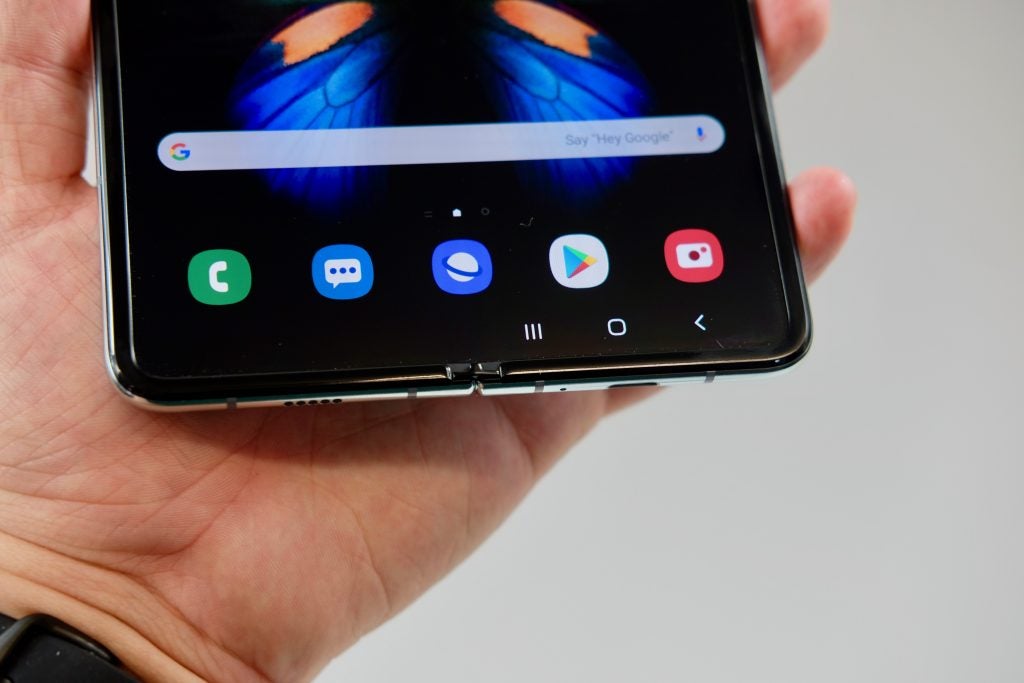
The speakers are good too: punchy and loud. However, the positioning on the sides does mean they can easily get blocked by your hands when the phone is unfolded.
While the phone lacks a headphone jack, Samsung has included a pair of its truly-wireless Galaxy Buds in the box. This is a nice touch and they’re a decent set of earphones if you’re not fussed about any ANC skills. These buds can also charge themselves upon the Fold thanks to the nifty Wireless Powershare feature.
Camera – Six sensors, but not top-of-the-class
There’s pretty much a camera everywhere you look on the Samsung Galaxy Fold. A 10-megapixel sensor sits on the front (or the Cover, as Samsung calls it), there are two inside (10MP f/2.2 26mm and 8MP f/1.9 24mm) and another three on the back.
These rear cameras mirror those on the Galaxy S10 and, while they take generally very good pictures, they’re comfortably below the standards set by the Pixel 4, iPhone 11 and Huawei Mate 30 Pro. I’d even say the £399 Pixel 3a takes better general pictures, even if it does lack the versatility of the Fold’s array.
The three rear cameras include a 12-megapixel main sensor with an aperture that’ll shift between f/1.5 and f/2.4, another 12-megapixel sensor for 2x zooming and a 16-megapixel ultra wide angle camera. It’s a versatile array that takes reliably good pictures in various situations with nice, typically saturated colours. Detail is strong to the point of looking slightly over-sharpened in some instances though, but is the look Samsung goes for and I know a lot of people really like it – and it does lead to very good Instagram pictures.
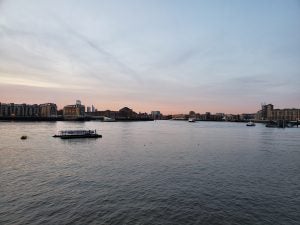
Colours are really nice, even when the light isn’t great
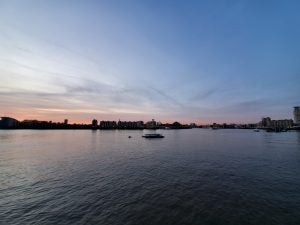
The wide camera is one of the best around

Another example of the wide camera
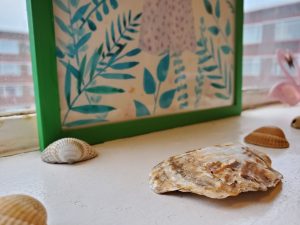
Detail is generally good, though sometimes shots can feel artificially sharpened
Where the Samsung Galaxy Fold’s main camera struggles, especially when compared to the Pixel 4 and iPhone 11, is dynamic range. The lightest and darkest points are often muddy and not as obvious as I would like. It comes out better with its ultra wide camera though, which consistently turns out sharper snaps than the iPhone 11. Of course the Pixel 4 lacks the ultra wide camera altogether.
You can take pictures with the Fold both open and closed. However, I didn’t particularly enjoy either option. Shooting with it closed is my preferred method as it doesn’t feel like you’re taking photos with a tablet, but it can be hard to get a proper view of what you’re shooting.
Where the folding nature does help is with selfies. The two internal sensors combine to snap really good pictures of yourself and the screen is big enough to get a great idea of what the final result will look like.
Video capture is impressive, with stable footage recorded and a versatile selection of shooting options.
Battery life – Far from a worry
I was originally very skeptical about the battery life here, even though the 4380mAh cell sounds sizable enough. There are those two screens to power, one of which is larger than other phones on the market
Thankfully during the two week review period I have been consistently impressed with the phone’s endurance. An hour of Netflix streaming on the larger display only took the battery down 9% and I was usually ending the day with 20-30% left. That would then get me through a decent portion of the next day before I would need to plug it in. In terms of the rudimentary screen-on time method, it got over six hours use on a few occasions.
This strong battery life is likely in part to my slightly different usage of the Fold when compared to other flagships. With the outer display showing notifications – and using less juice – you’re not always unfolding the display.
Wireless charging remains, as does the Wireless Powershare feature that enables you to place other Qi-enabled devices on the Fold’s back and juice them up. This is very handy for charging AirPods, for example, or a Galaxy Watch Active.
Related: Best phone
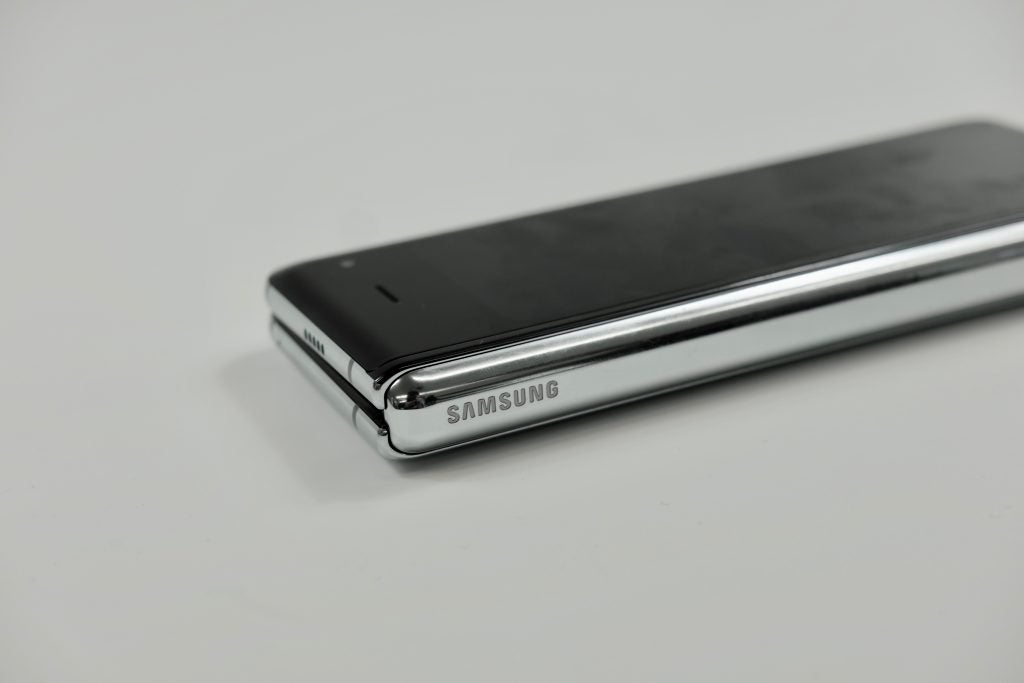
There are two batteries inside the Fold
In the box there’s 15w fast charger which will take the Fold from 0-100% in roughly one hour and 50 minutes. I managed to get from 0-40% in 40 minutes. These aren’t the fastest speeds on the market and this is one area the Fold already feels somewhat outdated. I’d expect the Fold 2 to come with much faster charging.
Should you buy the Samsung Galaxy Fold?
As much as the Galaxy Fold is a look at what the next wave of smartphones might be, at this stage it’s hard to recommend that anyone, aside from those who simply must have the first-gen of everything, actually spend nearly £2000 on it.
It’s impressive in a number of areas: great battery life, nice and productive software that actually makes some use of the bigger display and there are certain situations where having a tablet in smaller form-factor work.
But overall, it just feels like something that needs a lot of work. It’s far too delicate, has too many issues with the plastic inner display and doesn’t have a class-leading camera.
I have loved using the Galaxy Fold, and for Samsung to release something as genuinely new and exciting as this at a time when the majority of phones all feel very samey deserves plenty of appreciation. This is clearly a very innovative product that shows Samsung is going to be at the forefront of mobile innovation as we enter the next decade.
Verdict
More of a foldable tablet than a foldable phone, the Galaxy Fold excels in some areas and disappoints in others.
How we test phones
We test every mobile phone we review thoroughly. We use industry standard tests to compare features properly and we use the phone as our main device over the review period. We’ll always tell you what we find and we never, ever, accept money to review a product.


